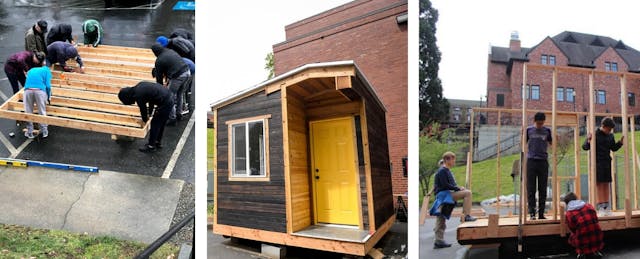Allow me a moment to brag about my students. During a recent bout of snow flurries, every single one of my students was outside helping hammer out some last-minute details on the tiny home we were building. Throughout the course of the project, all 16 of my students had demonstrated resilience and adaptability.
Once during the build, Joey had finished putting up a wall in the middle of a downpour, hustling to put the final pieces together even while drenched. Diego had demanded another shot at his work after the first attempt was, by his own admission, a disaster. Alex pulled me aside, frustrated that he wasn't on the same page as the rest of his team. Sean's refined presentation in front of several professionals demonstrated his hours of preparation. Dylan once stood up and proclaimed, “I'm not doing anything. How can I help?” Philip, after standing back and watching his teammates work for the better part of class, rallied to lead eight other classmates in lifting a major element of our work that each and every one of us applauded once complete.
My students don’t always work so collaboratively—they are ninth graders, after all, and are accustomed to working on individual assignments for the benefit of their own grades. But something about this project pulled them together. They weren’t completing an assignment for a grade, but building something for real people. And that meant it had to be good.
I teach a course called Architecture & Design in the new upper school for boys at Annie Wright Schools in Tacoma, Wash. Traditionally, Annie Wright’s high school had been all girls. After we opened a parallel all-boys high school, we launched the class to help galvanize our new learning community. We wanted students to understand how to make spaces for others as they share a space with one another, and we wanted to provide an experience where they set their learning at the service of something greater than themselves.
Our work culminates in a design-slash-build of a tiny house that, when completed, will be delivered to one of the Nickelsville sites in Seattle, which provide housing for people experiencing homelessness. While Nickelsvilles started as collections of tents in fenced-in areas, the last eight years have seen an increase in the amount of tiny homes that keep residents safe, warm and dry.
The Low Income Housing Institute (LIHI), based in Seattle, provides the land and coordinates service providers. LIHI is one of our key partners in the project, as well as my mentors at Sawhorse Revolution, an incredible organization that provides opportunities for high school students to design and build tiny homes. (We also are grateful for manufacturers such as Milgard and Absher Construction for the materials they provided, and for the architects at Mithun and Wren & Willow for their guidance on our work.)
The tiny home students end up building isn’t exactly like the ones you may have seen on TV or in magazines. By the time we hand it off to LIHI, it isn’t (yet) wired for electricity and won’t include indoor plumbing. At nine-by-three feet, it’s also, well, tiny, meaning students have to get creative about how to arrange storage, sleeping and community areas, along with concerns such as whether they can include enough elements to house a small family and how they can create accessibility for the range of physical abilities future residents might hold.

In the first two months of the course, we learn skills, concepts and mindsets related to architecture and design. We perform site visits to interview residents and study examples of houses already placed in Nickelsville. We sketch and draft our designs before rendering them in CAD software, which is used by architects and engineers. We perform critiques of each others’ work, learning how to offer and accept feedback from our classmates and from professional architects, and how we can iterate our designs based on that feedback. In the last three months of the course, we hold class in a parking lot, learning the carpentry skills necessary to construct the house, along with the furniture we designed for the interior.
Most importantly, though, we learn to see ourselves as designers and builders, as individuals who can understand a problem in the world and work together to build enough skills over a five-month period to help realize a solution to that problem. The experience is as much a lesson in leadership and collaboration as it is in design, and we create intentional opportunities to cultivate each of our students’ abilities to lead various parts of the project. The goal is to get them to realize the impact we make when we work on something greater than ourselves.
Make Space
Our classroom is a mess. We're surrounded by nail guns, power saws, tool carts, sawhorses and a variety of power cables and air tubes. Two-by-six foot planks of plywood are regularly hefted around the job site. Sometimes, a blowtorch churrs in one corner as we burn siding using the shou sugi ban technique to create a charred finish. Kindergarteners, teachers and other visitors are constantly stopping by to chat with us about our work. Without care, the environment can be distracting and dangerous, and between myself and our master carpenter, Karl Stromvall, there are two adults facilitating the work of 16 students.
Teams of students are asked to complete tasks they have little, if any, familiarity with beyond the short instructions we provide. Sometimes, the students succeed. Other times, they idle with confusion or waning motivation. At times, they make mistakes and must decide whether they should disassemble their work right away or make adjustments down the line.
In other words, our learning space is perfectly imperfect: We have enough supervision and expertise to guide the students to realize their goals, and the students have enough space to rise to challenges, encounter failure, encourage one another and stall out only to find a way over an obstacle and see a task to completion. It's how they react to any of these moments that helps instill the spirit of leadership and design in each of them.
Rapid, Frequent Feedback
Teaching in the messy, noisy space feels more like coaching than any project-based learning experience I have facilitated in more traditional classrooms. We're shouting encouragement amongst the clamor of tools, and we're moving from group to group, quickly demonstrating skills at the time of need, modeling a technique before asking a teammate to try it, and then moving on to another group.
When students seem to sputter, we huddle with them to demonstrate modes of feedback they can use with each other. It might be a quick opportunity for each teammate to express what they need to be successful. It might be “speed back,” or we might ask them to gesture a response to a prompt (“On the count of three, point to the person who's made the most positive impact today.”) And it might be an opportunity for a team to develop their soundtrack, something that inspires them and distills their work into a particular set of songs. Good feedback is often individual, such as a private conversation with a student who is worried his team is disengaged with him: What approaches might he try, and what role could he fill?
Cultivating Reflection
Throughout the build, my students create a portfolio that reflects their work. This contains early sketches, notes about site visits, images that helped inspire their designs and a photoessay of the elements they personally made that had an impact on the build. I collect these several times over the course of the semester, providing written feedback but also making notes on who to connect with during our build sessions.
During the project, I ask them to reflect on questions that might help them develop their sense of purpose:
- What qualities do you bring to your team that are utterly unique?
- Give yourself a nickname that represents the role you fill on your team. Explain why.
- Which classmate would you like to offer a shout out to for their work?
- What could you change about your work to become a better teammate?
Each of our three class meetings a week starts and begins with a spirit circle, an opportunity for me to celebrate major contributions that I saw on the site, and a chance for students to note major contributions they saw. We take this opportunity to set goals, provide shout outs, joke around and celebrate both the mistakes we made and the remedies found.

In June, we'll gather around the build site, and each of us will have a chance to sit in the house and write one last reflection for our portfolios. We'll then watch as a truck wedges itself under our structure as it prepares to haul it off to a tiny home community.
Moments later, the house gone, we'll be left with a parking lot that looks the same as it did before we spent months turning a pile of lumber into a home. Are we better teammates and leaders? Was what we did unforgettable? Did we, in whatever tiny way, learn how to learn to make a tangible difference in the world? During that moment, my students look proud. For them at least, they have.


